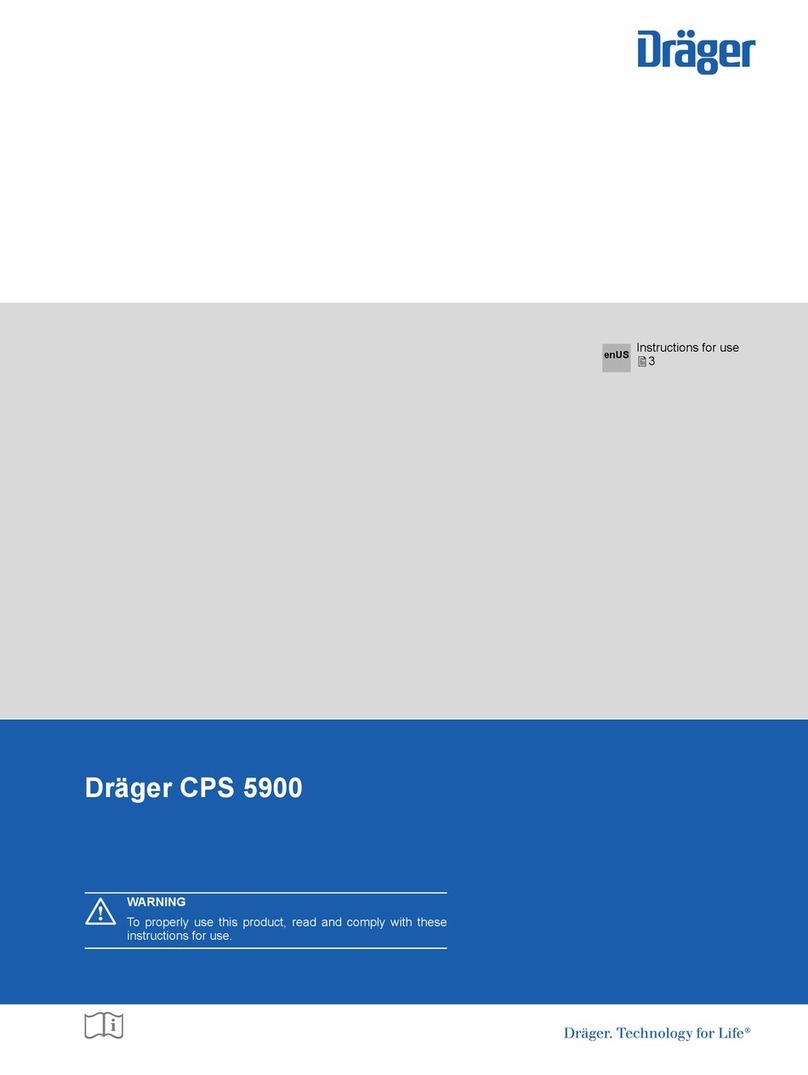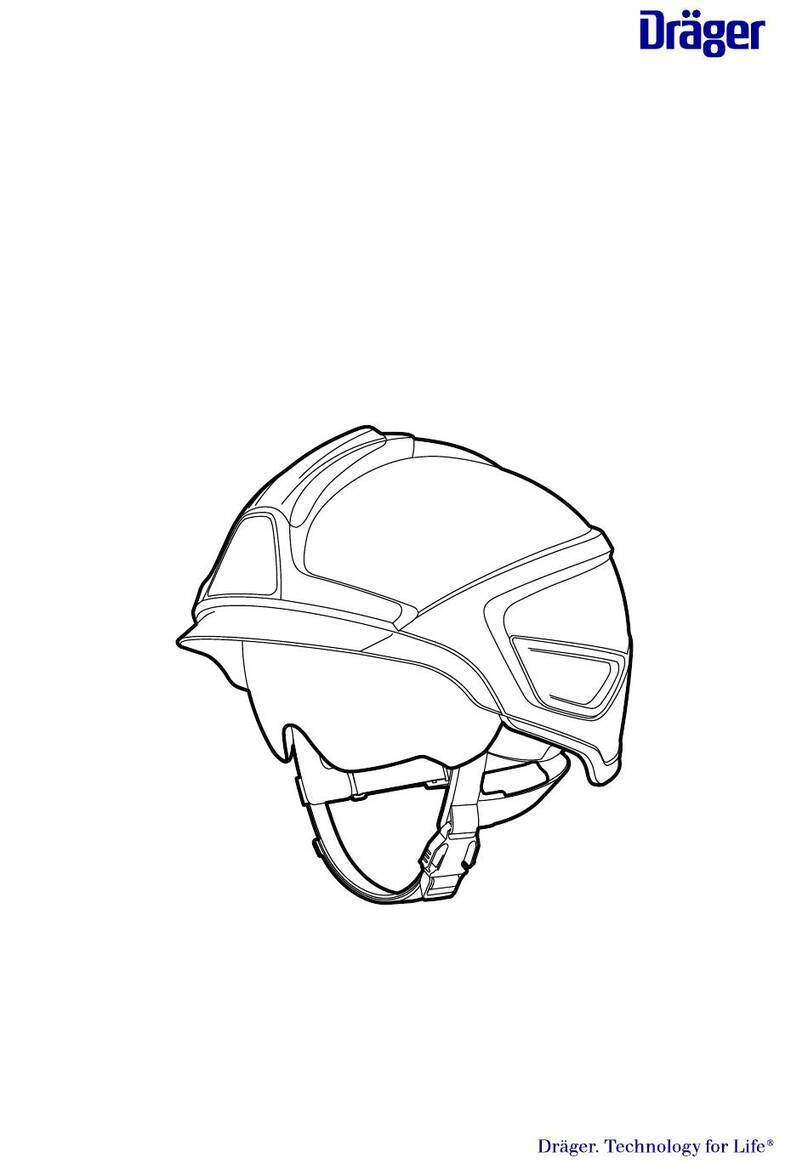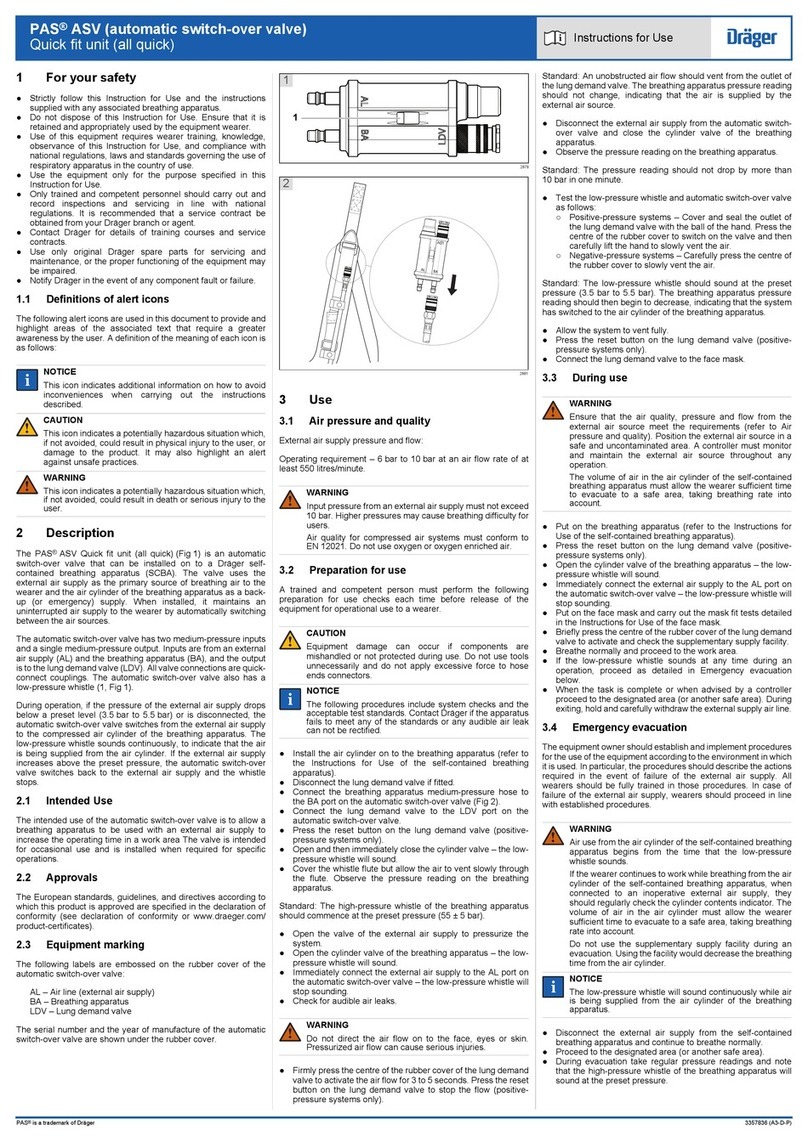
PAS®AirPack
Pneumatic Assembly Instructions for Use
PAS®is a registered trademark of Dräger 3357744 (A3-D-P) Page 1 of 3
1 For your safety
1.1 General safety statements
●Before using this product, carefully read the Instructions for Use.
●Strictly follow the Instructions for Use. The user must fully understand
and strictly observe the instructions. Use the product only for the
purposes specified in the Intended Use section of this document.
●Do not dispose of the Instructions for Use. Ensure that they are
retained and appropriately used by the product user.
●Only fully trained and competent users are permitted to use this
product.
●Comply with all local and national rules and regulations associated
with this product.
●Only trained and competent personnel are permitted to inspect, repair
and service the product. Dräger recommends a Dräger service
contract for all maintenance activities and that all repairs are carried
out by Dräger.
●Properly trained service personnel must inspect and service this
product as detailed in the Maintenance section of this document.
●Use only genuine Dräger spare parts and accessories, or the proper
functioning of the product may be impaired.
●Do not use a faulty or incomplete product, and do not modify the
product.
●Notify Dräger in the event of any component fault or failure.
●The air supply shall meet the requirements for breathing air according to
EN12021.
1.2 Definitions of alert icons
Alert icons are used in this document to provide and highlight text that
requires a greater awareness by the user. A definition of the meaning of
each icon is as follows:
WARNING
Indicates a potentially hazardous situation which, if not avoided,
could result in death or serious injury.
CAUTION
Indicates a potentially hazardous situation which, if not avoided,
could result in physical injury or damage to the product or
environment. It may also be used to alert against unsafe practices.
2 Description
2.1 Product overview
The Dräger PAS®AirPack Pneumatic Assembly is a pressure reducer and
gauge set that uses breathing air inputs to provide a medium-pressure output
(independent air supply) for one or two breathing apparatus wearers, or for
pneumatic tools or equipment.
Breathing air inputs are from high-pressure and/or medium-pressure
sources. The high-pressure input is from one or two breathing air cylinders.
The medium-pressure input is a regulated external supply from a factory
airline or compressor.
Referring to Fig 1, the features and components of the Pneumatic
Assembly are:
●The high-pressure input connectors (7) are standard cylinder-type
threaded connectors.
●The medium-pressure input connector (9) is a male quick connector
which has an internal non-return valve.
●The output connector (4) is a female quick connector, which has a
valve that self-seals when disconnected.
●A high-pressure gauge (1) indicates cylinder pressure.
●A medium-pressure gauge (2) indicates output pressure.
●A high-pressure whistle (10) sounds to indicate low cylinder pressure.
●A medium-pressure whistle (3) sounds to indicate low output pressure.
If the Pneumatic Assembly is using an external medium-pressure
supply, the whistle indicates that the external supply pressure is low.
●An internal pressure reducer converts the high-pressure input to a
medium-pressure output.
●A relief valve (5) in the medium-pressure system and bleed valves (8)
on the high-pressure connectors release air from the system when
operated.
The Pneumatic Assembly is available as a one-cylinder or two-cylinder
version. The two-cylinder version allows the user to remove depleted
cylinders and replace them with fully charged cylinders when required.
Repeatedly replacing alternate depleted cylinders can provide an
uninterrupted air supply to the attached breathing apparatus wearers.
Internal non-return valves (Fig 1, Item 6) ensure that air from the other
cylinder can not escape when a depleted cylinder is removed.
Holes in the corners of the front plate can be used to secure the Pneumatic
Assembly. The holes are: approximately 6.2 mm diameter; and
approximately 155 x 210 mm between centres.
2.2 Intended use
The Pneumatic Assembly is used with breathing air cylinders and an
external breathing air supply (works airline or compressor) to provide a
medium-pressure output. When used with approved Dräger airline
equipment, it supplies breathing air to one or two breathing apparatus
wearers.
It is intended to be used with only the air cylinder(s) connected (self-
contained use), or with the air cylinder(s) and an external medium-
pressure supply connected (external-supply use). When it is used with an
external supply the cylinders provide a backup air supply.
The breathing apparatus, cylinders and other accessories used with this
product must be certified Dräger components assembled in an approved
configuration. See Section 10 for the compatible airline equipment and
configurations. Contact Dräger for further information.
2.3 Approvals
The European standards, guidelines, and directives according to which
this product is approved are specified in the declaration of conformity (see
declaration of conformity or www.draeger.com/product-certificates).
2.4 Use in potentially explosive atmospheres
●The PAS AirPack Series is type tested as suitable for use in potentially
explosive atmospheres. The combinations are suitable for use in
hazardous areas of Zone 1 and 2 for explosion group IIA and IIB and for
Zone 21 and 22.
!
2.4.1 Special conditions for safe use
The Airline Systems shall not be used in the vicinity of processes where
high charges are generated if explosive atmospheres are present (for
example, where rapid filling processes are carried out – big bag filling – or
many actions of fast limit surface separation are done). In such cases,
hazardously high charges of the Airline Systems may occur due to
electrostatic induction.
The breathing apparatus and the compressed air cylinders which are used in
combination with the Airline Systems each have to meet the applicable
requirements of the equipment categories and explosion groups relevant to
the respective Airline System.
The Airline Systems have to be moved manually inside explosive
atmospheres by the user (pushing or pulling). It is mandatory to use floors
in Zone 1 and Zone 21 that are able to discharge electricity where dusts of
minimum ignition energies < 10 mJ are present.
If air supply hoses are used with a total length > 50 m, then the couplings which
are connected to the hoses in a conductive manner have to be provided with
an additional earth contact (after a hose length of 50 m) and integrated into the
operating eqipotential bonding.
●Do not charge the cylinder in a potentially explosive atmosphere.
2.5 Explanation of marking and symbols
Refer to the relevant authority for explanation of approval body symbols
and markings. Examples of other marking on the product:
BRBA-1359 – Dräger serial number
08/09 – Month and year of manufacture
3353261 – Dräger part number
HP – High pressure
MP – Medium pressure
– Medium-pressure input
– Medium-pressure output
– Relief valve
Where appropriate, the marking “F” on the apparatus and CAST
(compressed-air supply tube) indicates that both can be used where
flammability may be a risk. Marking on the compressed-air supply tube
indicates that the tube is heat resistant (H) and/or antistatic (S).
3 Use
WARNING
The cylinder and airline air quality shall meet the requirements for
breathing air according to EN 12021. Do not use oxygen or
oxygen-enriched air. The moisture content of breathing air should
be controlled within the EN 12021 limits to avoid freezing the
apparatus.
Carry out a risk assessment of the workplace to ensure that it is
not possible to connect to any airline supply other than breathable
air (e.g. Nitrox).
Before using airline equipment, ensure that the air supply meets
the air quality requirements, and complies with the airline
pressure, flow and hose requirements (see Section 8 and Section
10), and has been issued with a permit for use if necessary.
Position the Pneumatic Assembly in a safe and uncontaminated
area, and ensure that it is securely held or placed in a position
where it cannot be damaged.
Dräger recommend that the user carries out a risk assessment to
establish local procedures to be followed in the event of failure of
the air supply.
!
CAUTION
Impact damage to the Pneumatic Assembly may prevent cylinder
valve connection or cause an air leak. Handle the equipment with
care.
When remote wearers are connected to the Pneumatic Assembly, a
controller must be appointed to monitor the gauges and whistles of the
product throughout the operation. The controller must maintain the air
supply to the wearers and must ensure that any precautionary or
emergency signals are conveyed to the remote wearers in line with local
procedures and these Instructions for Use.
3.1 Preparation for use
1. Carry out a visual inspection (see Section 3.4.1).
2. Connect the air cylinder or cylinders (see Section 3.4.2).
3. Carry out a full functional test (see Section 3.4.5).
WARNING
Incorrect airline equipment configurations may result in insufficient
air flow to breathing apparatus wearers or increase the possibility
of air supply failure. See Section 10 for the compatible airline
equipment and configurations.
Prepare the breathing apparatus for use (see the Instructions for
Use supplied with the breathing apparatus). Observe the safety
information and carry out all preparation and functional testing
tasks before use.
Do not use the Pneumatic Assembly to supply air to more than two
breathing apparatus wearers at any time. If a controller is
appointed, and is required to wear breathing apparatus and to
connect to the equipment then only one other user is permitted.
4. Connect the airline equipment (extension hoses, Y-piece, etc.) to the
medium-pressure output connector (Fig 2).
5. Depending on the required use, do one of the following:
○Self-contained use – Fully open the cylinder valve (open only one
cylinder valve on a two cylinder version).
○External-supply use – Connect the external supply (see
Section 3.4.4). Ensure that cylinder valves are fully closed.
6. Put on the breathing apparatus and connect to the airline equipment
(Fig 3 shows a typical breathing apparatus connector).
3.2 During use
WARNING
An appointed controller or the breathing apparatus wearers must
monitor the Pneumatic Assembly gauges and whistles during use.
Procedures to warn and evacuate remote users must be in place.
The effective working duration of the equipment is dependent on
the initial air supply available and the breathing rate of the wearers.
Do not commence any operation using a cylinder that is less than
80 per cent full.
At very high work rates the pressure in the face mask of a
breathing apparatus wearer may become negative at peak
inhalation flow.
●Breathe normally and proceed to the work area taking care with any
airline equipment.
●On receipt of an evacuation signal, withdraw immediately to a safe
area (see local instructions for full evacuation procedures).
●When the task is complete, withdraw to a safe area before removing
the breathing apparatus.
●The high-pressure and medium-pressure whistles indicate that there is
low pressure in the associated system. If a warning whistle sounds,
carry out the necessary actions depending on the configuration of the
Pneumatic Assembly (see Sections 3.2.1 or 3.2.3).
3.2.1 Medium-pressure whistle sounds during external-supply use
Fully open one cylinder valve, and disconnect the external supply from the
Pneumatic Assembly. Continue the task as a self-contained use task.
3.2.2 Medium-pressure whistle sounds during self-contained use
Breathing apparatus wearers must proceed in line with breathing
apparatus Instructions for Use and local procedures.
3.2.3 High-pressure whistle sounds during self-contained use
●If there is a second/offline fully-charged cylinder connected to the
Pneumatic Assembly, proceed as follows:
a. Fully open the valve of the second/offline cylinder.
b. Close the valve of the empty cylinder and then open its bleed valve.
c. If a replacement cylinder is available, immediately remove the
empty cylinder (see Section 3.4.3) and fit a replacement (fully
charged) cylinder (see Section 3.4.2).
●If the second/offline cylinder is empty, or there is no second/offline
cylinder connected: breathing apparatus wearers must proceed in line
with breathing apparatus Instructions for Use and local procedures.
3.3 After use
WARNING
Do not remove the breathing apparatus until in a safe breathing
environment.
1. Once in a safe area, remove all breathing equipment.
2. Disconnect the external supply from the Pneumatic Assembly and fully
close all cylinder valves.
3. Pull the handle of the relief valve (Fig 1, Item 5) to vent all air from the
system.
4. Disconnect any airline equipment from the Pneumatic Assembly and
fit all protection caps.
5. Disconnect the air cylinders if necessary (see Section 3.4.3).
6. Carry out the after use maintenance tasks in the maintenance table
(see Section 5.1).
3.4 Common user tasks
3.4.1 Visual inspection
Check that the Pneumatic Assembly is clean and undamaged, paying
particular attention to pneumatic components, hoses and connectors.
Typical signs of damage that may affect the operation of the Pneumatic
Assembly include impact damage, abrasion, cutting, corrosion and
discolouration. Report damage to service personnel or Dräger and do not
use the Pneumatic Assembly until faults are rectified.












































